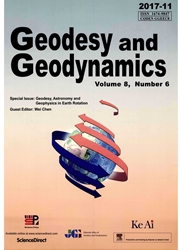

 中文摘要:
中文摘要:
基于中国大陆1998~2007年(复测周期2~3年)流动重力观测数据,结合GPS、水准观测成果和区域地质构造动力环境,分析研究了汶川8.0级地震区域重力场动态变化演化特征和孕震机理.结果表明:区域重力场动态演化大体反映了青藏高原物质东流的动态效应和汶川大震孕育的中长期(2~10年)信息;汶川大震孕育的显著重力标志为震中西南持续多年的正重力变化(上升)和出现较大规模的重力变化梯级带,前者有利于地震能量的不断积累,后者有利于地震剪切破裂的发生;与地震孕育相关重力场变化总体呈增大—加速增大—减速增大—发震的过程;8年累积重力变化幅差最大约200×10^-8m·s^-2;2001年昆仑山口8.1级地震孕育发生和震后恢复调整,对区域重力场动态变化和汶川大震的孕育发展具有重要影响;松潘—甘孜块体一般呈现负重力变化,可能反映深部壳幔局部上隆、壳内温度较高而膨胀,有利于逆冲或推覆体运动的形成和大震的发生.
 英文摘要:
英文摘要:
Based on the gravity observations from 1998 to 2007 of China mainland which repeated every 2-3 years, and considering the GPS and leveling measurements and the regional environment of tectonics and geodynamics, we analyze the characteristics of regional dynamic gravity field evolution and the preparation mechanics of the Wenchuan Ms8.0 earthquake in 2008. The result shows that variations of the regional gravity field reflect the dynamic effect of eastward flow of the Tibetan plateau and the preparation information of mid-and-long term, that is 2 to 10 years, of the Wenchuan earthquake. The obvious gravity indicators related to the Wenchuan earthquake preparation are the positive gravity changes in southwest of epicenter which lasted many years, which is in favor of the continuous accumulation of seismic energy, and the relatively large-scale gradient zone of gravity changes, which is in favor of occurrence of seismic rupture. The gravity change process associated with the earthquake preparation is increasing, accelerated increasing and decelerated increasing followed by the occurrence of the earthquake. The total gravity change accumulated over 8 years may come up to 200×10^-8m·s^-2. The preparation and occurrence of the Kunlunshan Ms8.1 earthquake in 2001 and the adjustment after this earthquake significantly affected the regional dynamic gravity changes and the preparation of the Wenchuan earthquake. The gravity change in the Songpan-Garzê block is negative, which may reflects the local uplift of deep crust-mantle and the crust expansion that resulted from the relatively high temperature inside, which might promote the thrust or nappe movement and the occurrence of the large earthquake.
 同期刊论文项目
同期刊论文项目
 同项目期刊论文
同项目期刊论文
 期刊信息
期刊信息
